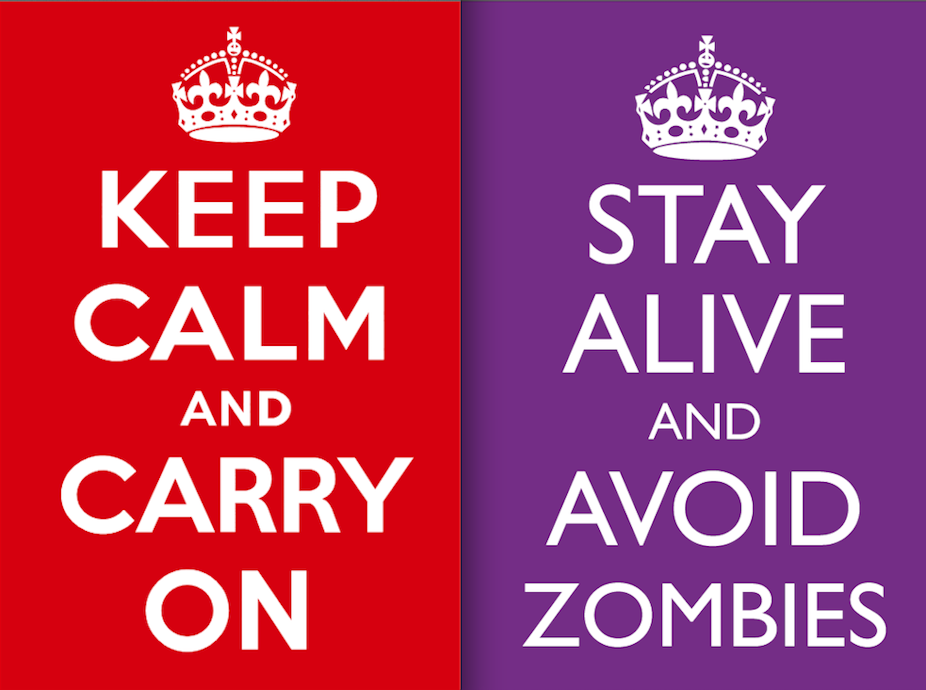“Keep Calm and Carry On” is now one of the most recognisable slogans in British history. Its resilient message has become extraordinarily commonplace, with the phrase used to sell everything from mugs to flight bags and baby clothes. An engraving shop on my daily commute even invokes its customers to “Keep Calm and Order Signage”. Its formula is instantly recognisable, whether referring to zombies or knitting.
This pervasiveness has served to reinforce a popular view of life on the Home Front during World War II. It also obscures the complicated history of a poster that was designed on this day 75 years ago, but surprisingly was not seen in public until very recently, in 2001.
Lost and Found
The slogan was coined following a meeting between Ministry of Information officials and the Treasury on 27 June 1939. It was designed to lead a series of three “Home Publicity” posters that would be issued in the event of war and 2.45 million copies were printed in the days before World War II was declared. But its display was never officially authorised, and so never went ahead.
Only a handful of the originals survived when stocks were pulped during an extensive wartime recycling campaign. Some of the posters had been distributed to police stations for safe-keeping and were accidentally overlooked, but even these remained hidden from view for more than 60 years.
This would all change when a dusty copy of the “Keep Calm” poster was re-discovered at the turn of the 21st century. It was found in 2000 within a box of books bought at auction by Stuart and Mary Manley, the owners of a second hand book shop in Alnwick, Northumberland. The Manleys decided to display the poster it in their shop and began to sell reproductions in 2001.
Other companies followed suit and versions of the “Keep Calm” message were soon being attached to a bewildering array of products. This even led to a series of legal battles over copyright during 2011-13 (with UK courts concluding that the design was covered by Crown Copyright rules and was now firmly in the public domain).
So here we have a poster that was not even used for its original purpose during the war yet has seen mass popularity upon its rediscovery. The timeless nature of the stylistic and predominantly textual design goes some way towards explaining this. Another reason might be to do with its message of sober restraint, which chimes with expectations about the history of World War II and was appropriated by many commentators during the recent economic downturn.
And then fundamental to this are the technological advances that have made the slogan’s reproduction and manipulation so easy. It’s hard to imagine such that rapid commercialisation could have taken hold in the pre-internet age. It was the very fact that the poster was hidden until 2001 that allowed it to go viral.
A question of tone
A four-year research project on the Ministry of Information being undertaken by the University of London’s Institute of English Studies and King’s College London is shedding new light on the previously hidden parts of the poster’s history. It’s shown that the early history of “Keep Calm and Carry On” is particularly intriguing, as it doesn’t quite confirm the settled notions and assumptions of our time.
It’s now clear that the poster was the result of a compromise designed to save money for the Exchequer, and that the decision to keep the poster “in reserve” was only taken after the war had begun. So it’s something of an irony that this decision was influenced by a belief that the phrase was “too commonplace to be inspiring” and official fears that “it may even annoy people that we should seem to doubt the steadiness of their nerves”. The Treasury was adamant that the public would “resent having [the message] crammed down their throats at every turn”.
One cannot help but wonder what those who made this decision would make of the poster’s recent commercialisation. They would perhaps take comfort from the fact that effective public relations owes much to timing. So “Keep Calm and Carry On” is as much, if not more, a part of our history as it is of theirs.

